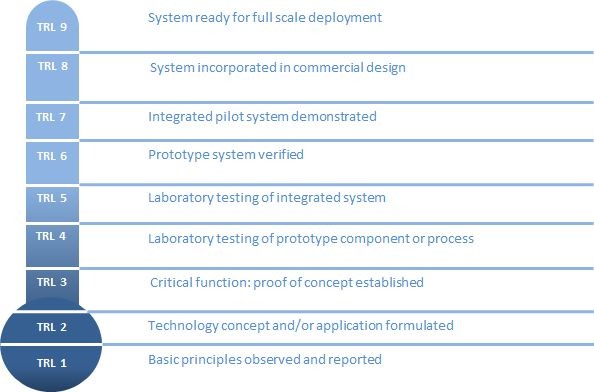TRL Scale

The TRL scale is a metric for describing the maturity of a technology. The acronym stands for Technology Readiness Level. The scale consists of 9 levels. Each level characterises the progress in the development of a technology, from the idea (level 1) to the full deployment of the product in the marketplace (level 9).
This scale was developed by NASA in the 70s to assess the maturity of a technology prior to integrating this technology into a system. It contained 7 levels at that time. Nowadays, 9 levels compose the scale. These levels are detailed below.
Level 1 - Basic Research: basic principles are observed and reported
Lowest level of technology readiness. Scientific research begins to be translated into applied research and development. Examples might include fundamental investigations and paper studies.
Level 2 – Applied Research: technology concept and/or application formulated
Once basic principles are observed, practical applications can be formulated. Examples are limited to analytic studies and experimentation.
Level 3 – Critical function, proof of concept established
Active research and development is initiated. Laboratory studies aim to validate analytical predictions of separate components of the technology. Examples include components that are not yet integrated or representative.
Level 4 – Laboratory testing of prototype component or process
Design, development and lab testing of technological components are performed. Here, basic technological components are integrated to establish that they will work together. This is a relatively “low fidelity” prototype in comparison with the eventual system.
Level 5 – Laboratory testing of integrated system
The basic technological components are integrated together with realistic supporting elements to be tested in a simulated environment. This is a “high fidelity” prototype compared to the eventual system.
Level 6 – Prototype system verified
The prototype, which is well beyond that of level 5, is tested in a relevant environment. The system or process demonstration is carried out in an operational environment.
Level 7 – Integrated pilot system demonstrated
Prototype is near, or at, planned operational system level. The final design is virtually complete. The goal of this stage is to remove engineering and manufacturing risk.
Level 8 – System incorporated in commercial design
Technology has been proven to work in its final form under the expected conditions. In most of the cases, this level represents the end of true system development.
Level 9 – System ready for full scale deployment
Here, the technology in its final form is ready for commercial deployment.
Level beyond 9 - Market introduction
The product, process or service is launched commercially, marketed to and adopted by a group of customers (including public authorities).
